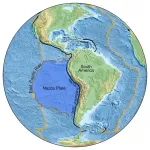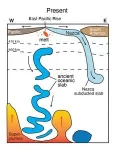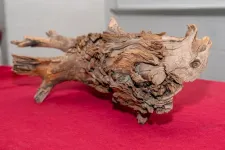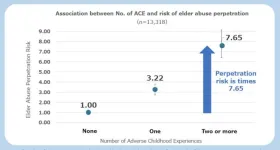Ancient sunken seafloor reveals earth’s deep secrets
University of Maryland geologists discover a mysterious subduction zone deep beneath the Pacific Ocean, reshaping our understanding of Earth’s interior.
2024-09-27
(Press-News.org) University of Maryland scientists uncovered evidence of an ancient seafloor that sank deep into Earth during the age of dinosaurs, challenging existing theories about Earth’s interior structure. Located in the East Pacific Rise (a tectonic plate boundary on the floor of the southeastern Pacific Ocean), this previously unstudied patch of seafloor sheds new light on the inner workings of our planet and how its surface has changed over millions of years. The team’s findings were published in the journal Science Advances on September 27, 2024.
Led by geology postdoctoral researcher Jingchuan Wang, the team used innovative seismic imaging techniques to peer deep into Earth’s mantle, the layer between our planet’s crust and core. They found an unusually thick area in the mantle transition zone, a region located between about 410 and 660 kilometers below the Earth’s surface. The zone separates the upper and lower mantles, expanding or contracting based on temperature. The team believes that the newly discovered seafloor may also explain the anomalous structure of the Pacific Large Low Shear Velocity Province (LLSVP)—a massive region in Earth’s lower mantle—as the LLSVP appears to be split by the slab.
“This thickened area is like a fossilized fingerprint of an ancient piece of seafloor that subducted into the Earth approximately 250 million years ago,” Wang said. “It’s giving us a glimpse into Earth’s past that we’ve never had before.”
Subduction occurs when one tectonic plate slides beneath another, recycling surface material back into Earth's mantle. The process often leaves visible evidence of movement, including volcanoes, earthquakes and deep marine trenches. While geologists typically study subduction by examining rock samples and sediments found on Earth’s surface, Wang worked with Geology Professor Vedran Lekic and Associate Professor Nicholas Schmerr to use seismic waves to probe through the ocean floor. By examining how seismic waves traveled through different layers of Earth, the scientists were able to create detailed mappings of the structures hiding deep within the mantle.
“You can think of seismic imaging as something similar to a CT scan. It’s basically allowed us to have a cross-sectional view of our planet’s insides,” Wang said. “Usually, oceanic slabs of material are consumed by the Earth completely, leaving no discernible traces on the surface. But seeing the ancient subduction slab through this perspective gave us new insights into the relationship between very deep Earth structures and surface geology, which were not obvious before.”
What the team found surprised them—material was moving through Earth’s interior much more slowly than previously thought. Wang believes that the unusual thickness of the area the team discovered suggests the presence of colder material in this part of the mantle transition zone, hinting that some oceanic slabs get stuck halfway down as they sink through the mantle.
“We found that in this region, the material was sinking at about half the speed we expected, which suggests that the mantle transition zone can act like a barrier and slow down the movement of material through the Earth,” Wang explained. “Our discovery opens up new questions about how the deep Earth influences what we see on the surface across vast distances and timescales.”
Looking ahead, the team plans to extend their research into other areas of the Pacific Ocean and beyond. Wang hopes to create a more comprehensive map of ancient subduction and upwelling (the geological process that occurs when subducted material heats up and rises to the surface again) zones, as well as their effects on both deep and surface Earth structures. With the seismic data acquired from this research, Wang and other scientists are improving their models of how tectonic plates have moved throughout Earth’s history.
“This is just the beginning,” Wang said. “We believe that there are many more ancient structures waiting to be discovered in Earth’s deep interior. Each one has the potential to reveal many new insights about our planet’s complex past—and even lead to a better understanding of other planets beyond ours.”
###
The paper, “Mesozoic intraoceanic subduction shaped the lower mantle beneath the East Pacific Rise,” was published in Science Advances on September 27, 2024.
This research was supported by NASA SSERVI Cooperative Agreement No. 80NSSC19M0216. This article does not necessarily reflect the views of this organization.
END
[Attachments] See images for this press release:


ELSE PRESS RELEASES FROM THIS DATE:
2024-09-27
As Mark Hasegawa-Johnson combed through data from his latest project, he was pleasantly surprised to uncover a recipe for Eggs Florentine. Sifting through hundreds of hours of recorded speech will unearth a treasure or two, he said.
Hasegawa-Johnson leads the Speech Accessibility Project, an initiative at the University of Illinois Urbana-Champaign to make voice recognition devices more useful for people with speech disabilities.
In the project’s first published study, researchers asked an automatic ...
2024-09-27
NEW YORK, September 27, 2024 – Water scarcity, pollution, and the burden of waterborne diseases are urgent issues threatening global health and security. A recently published study in the journal Global Environmental Change highlights the pressing need for innovative economic strategies to bolster water security investments, focusing on the “enabling environment” that influences regional readiness for new business solutions.
Initiated and led by researchers at the Advanced Science Research Center at the CUNY Graduate Center (CUNY ASRC), ...
2024-09-27
The study, published in Lancet Neurology, detailed the “head-to-head” trial implemented by the researchers to test two drugs, mexiletine and lamotrigine, on people with the condition.
The trial, which was conducted at the UCL Queen Square Multidisciplinary Centre for Neuromuscular Diseases and the National Hospital for Neurology and Neurosurgery, UCLH, involved 60 adults with confirmed non-dystrophic myotonia.
Patients were randomly assigned to receive either mexiletine for eight weeks followed by lamotrigine for eight weeks, or the reverse order, with a seven-day ...
2024-09-27
HOUSTON ― The University of Texas MD Anderson Cancer Center has posthumously awarded Michael Frumovitz, M.D., with the Julie and Ben Rogers Award for Excellence in Patient Care. The annual award recognizes employees who consistently demonstrate excellence in their work and dedication to MD Anderson’s mission to end cancer. The award’s focus rotates among the areas of patient care, research, education, prevention and administration, with this year’s award focusing on patient care.
Frumovitz dedicated more than 20 years of service to MD Anderson, most recently as chief patient experience officer and professor in Gynecologic ...
2024-09-27
A University of Arizona College of Medicine – Phoenix researcher was recently awarded a $1.9 million National Institutes of Health grant to study the molecular mechanisms of how dilated cardiomyopathy progresses to heart failure, which could eventually lead to better preventive and treatment options for heart failure.
Heart failure is inextricably linked with dilated cardiomyopathy, or DCM, a disease characterized by the progressive enlargement of the heart and reduced contractility reflected by reduced ejection fraction. ...
2024-09-27
Clinical cancer research in the U.S. is increasingly dominated by pharmaceutical industry sponsors, study finds
Study underscores need for increased investment in federally funded cancer clinical trials
SEATTLE – September 27, 2024 – Researchers at Fred Hutch Cancer Center identified a substantial increase over the past decade in the proportion of patients with cancer in the U.S. who participate in pharmaceutical industry sponsored clinical trials compared to those conducted with federal government support. Published in The Journal of Clinical Oncology and presented at the ASCO Quality Care Symposium, these findings reveal trends of underinvestment in federally ...
2024-09-27
A new study published in the journal Science suggests that an ordinary old log could help refine strategies to tackle climate change.
A team of researchers led by University of Maryland Atmospheric and Oceanic Science Professor Ning Zeng analyzed a 3,775-year-old log and the soil it was excavated from. Their analysis, published on September 27, 2024, revealed that the log had lost less than 5% carbon dioxide from its original state thanks to the low-permeability clay soil that covered it.
“The wood is nice and solid—you could probably make a piece of furniture out of it,” Zeng noted.
Understanding the ...
2024-09-27
Preterm births have increased by more than 10 percent over the past decade, with racial and socioeconomic disparities persisting over time, according to a new study analyzing more than five million births.
The study, published in the journal JAMA Network Open, also found that some factors that increase the risk for preterm birth—such as diabetes, sexually transmitted infections, and mental health conditions—became much more common over the past decade, while other factors that protect against preterm birth declined.
“Our findings not only show that preterm births are on the rise, but provide clues as ...
2024-09-27
About The Study: The results of this cross-sectional study show that over the past 2 decades, menopausal hormone therapy use declined among U.S. postmenopausal women of all age and racial and ethnic groups. Women of racial and ethnic minority groups had lower prevalence of menopausal hormone therapy use compared to non-Hispanic white women.
Corresponding Authors: To contact the corresponding authors, email Lin Yang, PhD, (lin.yang@ahs.ca) and Adetunji T. Toriola, MD, PhD, MPH, (a.toriola@wustl.edu).
To access the embargoed study: Visit our For The Media website at this link https://media.jamanetwork.com/
(doi:10.1001/jamahealthforum.2024.3128)
Editor’s ...
2024-09-27
New research shows the connection between adverse childhood experiences (ACEs), such as physical or emotional abuse, and an increased risk of people growing up to be abusive against older generations. While generational trauma is known to be passed down from parent to child, the study showed that it can also reverberate upwards from parent to older generations. A survey of over 13,000 people in Japan found that about half had one or more ACEs. Of these, 8.5% self-reported committing some form of physical or verbal abuse against people aged over 65. An important contributing factor was the person’s mental and physical health, both of which are known to be affected by ...
LAST 30 PRESS RELEASES:
[Press-News.org] Ancient sunken seafloor reveals earth’s deep secrets
University of Maryland geologists discover a mysterious subduction zone deep beneath the Pacific Ocean, reshaping our understanding of Earth’s interior.





